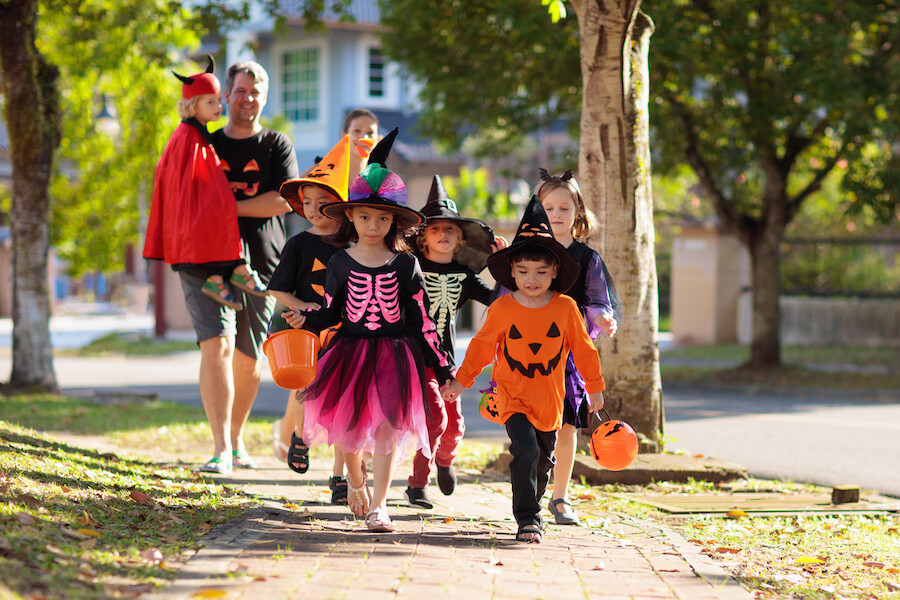Trick-or-Treating Safety Tips
Costumes, candy, and nighttime adventures are all part of the fun, but they come with risks that can be managed with some simple precautions:
- Choose well-fitting, flame-resistant costumes: Ill-fitting costumes can be a tripping hazard, and some materials are more flammable than others. Always check labels for flame resistance to minimize fire risk from candles or other decorations.
- Increase visibility: If your child’s costume is dark, add reflective tape or glow-in-the-dark stickers to both the costume and their treat bag. This makes them easier to spot for drivers and others in the dark. Light-colored costumes are a safer choice for visibility.
- Opt for face paint instead of masks: Masks can obstruct your child’s vision and breathing. If you choose to use a mask, ensure it has large eyeholes and good airflow.
- Stay together: For younger children, it’s best to accompany them while trick-or-treating. If your children are older and trick-or-treating without an adult, ensure they go in groups and stick to familiar neighborhoods.
- Use safe routes: Only trick-or-treat at well-lit homes with decorations. If a house has its lights off, it’s a sign they aren’t participating in Halloween activities.
- Inspect candy: Before allowing your child to indulge in their candy haul, inspect everything to ensure it’s properly sealed. Discard any unwrapped or suspicious-looking candy.
Halloween Candy and Healthy Eating Habits
While candy is synonymous with Halloween, it’s important to encourage healthy eating habits even during this festive time. The Centers for Disease Control and Prevention (CDC) reports that the average American child consumes between 3,500 and 7,000 calories of candy on Halloween. Overconsumption of sweets can lead to long-term health issues, such as obesity, tooth decay, and diabetes. However, with a few smart strategies, you can help your child enjoy treats in moderation.
Here are Some Ways to Manage Candy Consumption:
- Set limits on candy intake: Establish a clear rule about how much candy your child can have each day after Halloween. This helps them enjoy their treats without overindulging in one sitting.
- Serve candy with meals: Eating candy alongside a balanced meal can help slow down the sugar absorption and avoid sudden spikes in blood sugar.
- Promote healthier options: While candy is part of the fun, consider offering healthier alternatives like dark chocolate, which contains less sugar than milk chocolate. Sugar-free candies are another good option, particularly for children with dietary restrictions.
- Encourage balance with other snacks: Instead of filling up solely on candy, offer nutritious snacks like fruits, vegetables, or whole grains. This will help fill your child up with fiber and nutrients while leaving room for a few sweet treats.
Teaching Healthy Habits Early On
Halloween is a great opportunity to start conversations with your child about making healthier food choices:
- Explain the importance of moderation: Help your child understand that candy is a treat to be enjoyed in small amounts. Teaching them this early helps establish lifelong healthy eating habits.
- Model healthy behaviors: As a parent, your example can speak louder than words. Limit your own candy intake and enjoy Halloween treats mindfully to set a positive example.
- Get creative with leftover candy: Consider “buying” some of your child’s candy to reduce the amount they have on hand. You can also donate extra candy to local charities or dental offices participating in candy buy-back programs.
Additional Halloween Safety Tips
- Keep your home safe for trick-or-treaters: If you’re handing out candy, ensure that your walkway is well-lit, clear of obstacles, and free of tripping hazards like loose decorations. Consider using battery-operated candles instead of open flames to prevent accidental fires.
- Allergy awareness: Be mindful of children with food allergies. Consider offering non-food treats like stickers, glow sticks, or small toys, which are great alternatives for kids with dietary restrictions. Houses participating in the “Teal Pumpkin Project” display a teal-colored pumpkin, indicating they offer non-food treats.
- Stay hydrated: Halloween activities can be surprisingly exhausting, especially for children. Encourage them to drink water throughout the evening, as sugary treats can lead to dehydration.
Final Thoughts
Halloween should be a time of fun and excitement, but safety and health should always come first. By following these safety and healthy-eating tips, you can ensure that your child enjoys a memorable Halloween without the risks that can sometimes accompany the holiday.
